Tesco's Management Concepts and Academic Practice Report - UCC
VerifiedAdded on 2023/06/15
|11
|2908
|123
Report
AI Summary
This report provides an analysis of Tesco's management approaches, strategies, and organizational behavior, including motivation, organizational culture, and staffing structure. It begins with an overview of Tesco, highlighting its history, products, and target market. The report then delves into Tesco's management approach, focusing on its demographic style and participative management. Furthermore, it discusses Tesco's expansion and marketing strategies, including product, pricing, place, and promotional elements. The organizational behavior section covers staffing numbers, hierarchical structure, motivating factors, and organizational culture. The report also examines macro environmental factors affecting Tesco through a PESTLE analysis, considering political, economic, social, technological, environmental, and legal aspects. The analysis concludes by emphasizing Tesco's customer-oriented organizational culture and its efforts towards sustainability and community support.
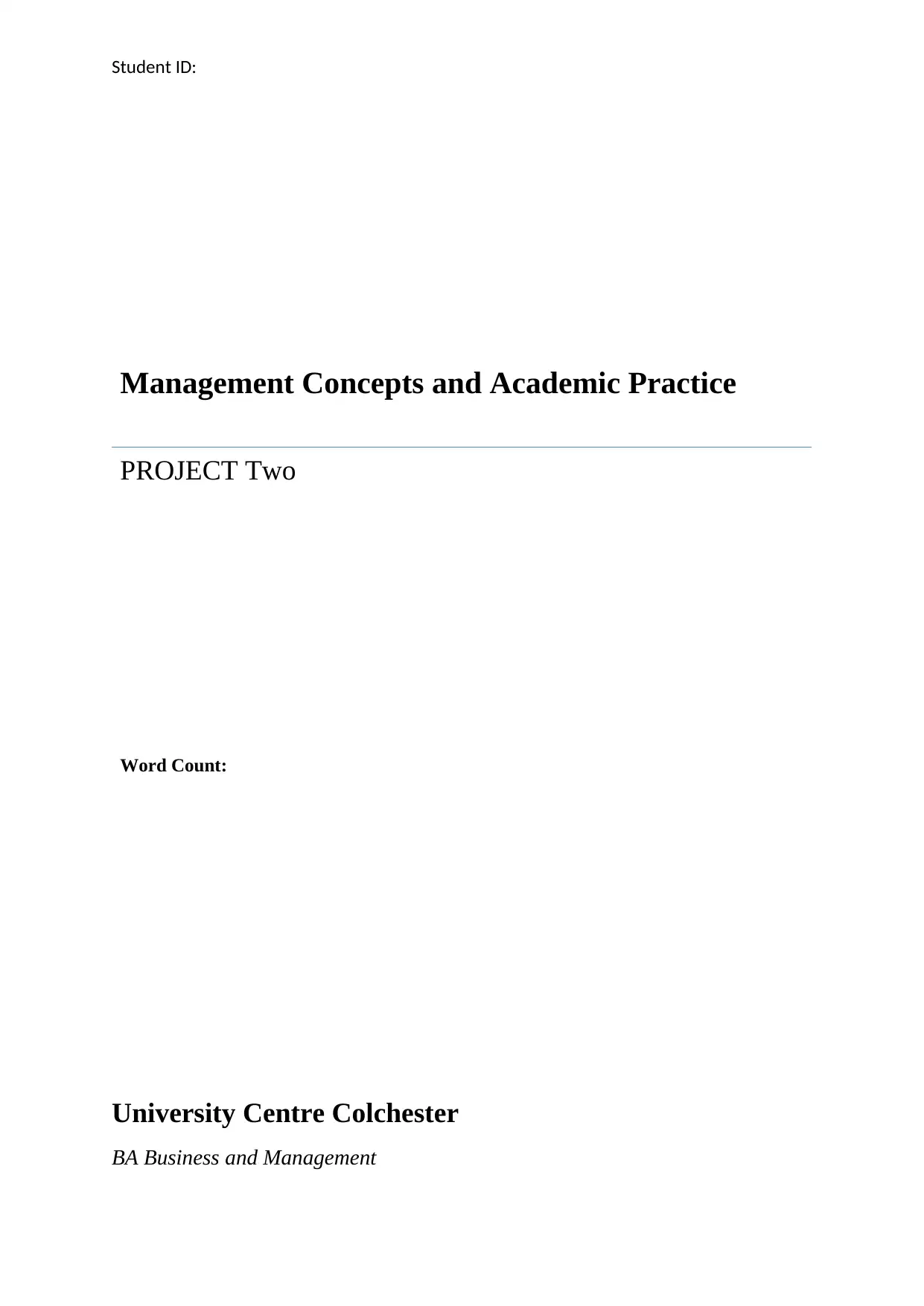
Student ID:
Management Concepts and Academic Practice
PROJECT Two
Word Count:
University Centre Colchester
BA Business and Management
Management Concepts and Academic Practice
PROJECT Two
Word Count:
University Centre Colchester
BA Business and Management
Paraphrase This Document
Need a fresh take? Get an instant paraphrase of this document with our AI Paraphraser

Student ID:
Year One
Year One

Student ID:
Table of Contents
INTRODUCTION....................................................................................................................................... 1
COMPANY OVERVIEW........................................................................................................................... 1
MANAGEMENT APPROACH................................................................................................................... 2
STRATEGY................................................................................................................................................ 2
ORGANIZATIONAL BEHAVIOUR.......................................................................................................... 3
MACRO ENVIRONMENTAL FACTORS................................................................................................. 4
CONCLUSION........................................................................................................................................... 4
REFERENCE LIST.................................................................................................................................................5
Table of Contents
INTRODUCTION....................................................................................................................................... 1
COMPANY OVERVIEW........................................................................................................................... 1
MANAGEMENT APPROACH................................................................................................................... 2
STRATEGY................................................................................................................................................ 2
ORGANIZATIONAL BEHAVIOUR.......................................................................................................... 3
MACRO ENVIRONMENTAL FACTORS................................................................................................. 4
CONCLUSION........................................................................................................................................... 4
REFERENCE LIST.................................................................................................................................................5
⊘ This is a preview!⊘
Do you want full access?
Subscribe today to unlock all pages.

Trusted by 1+ million students worldwide
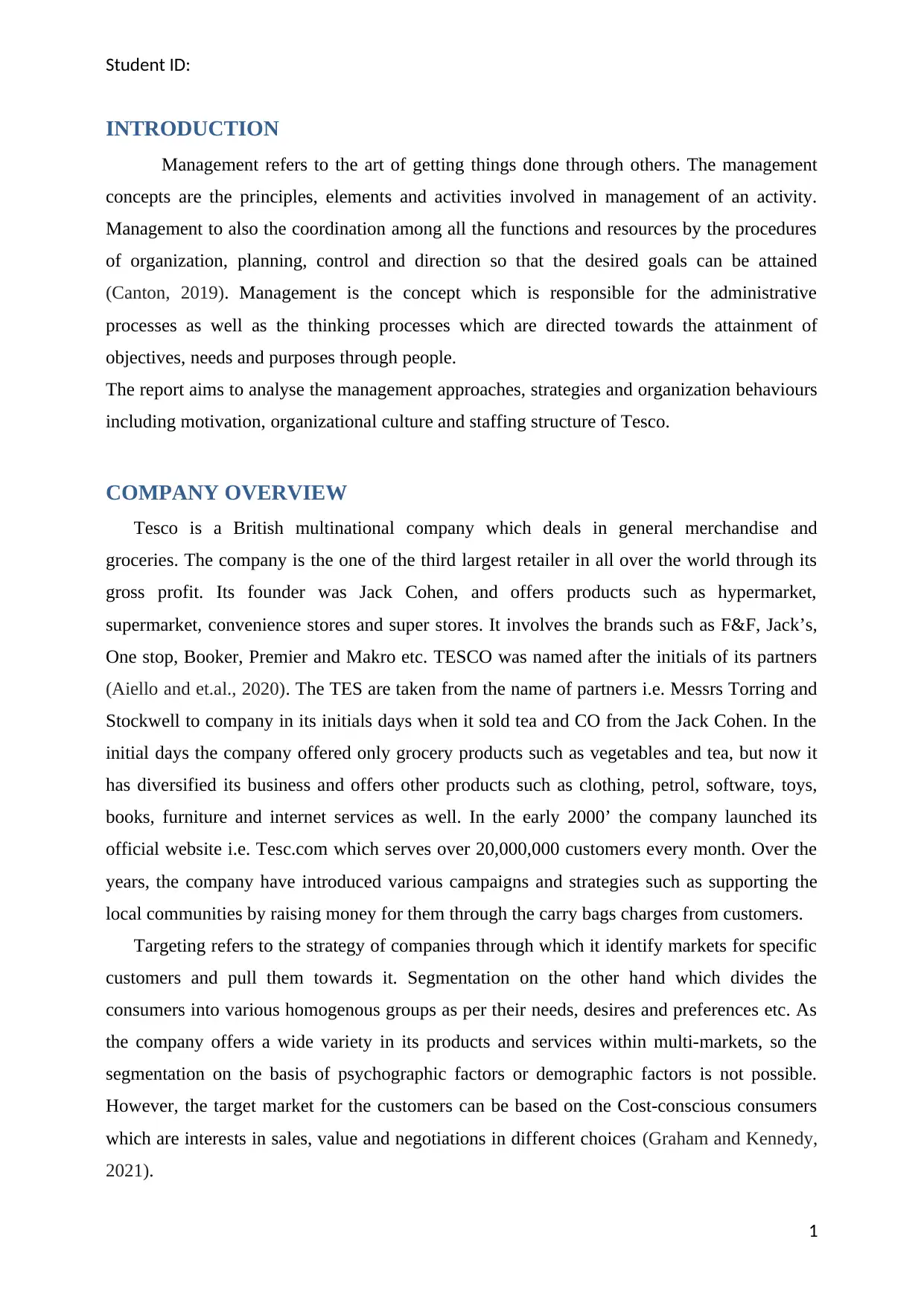
Student ID:
INTRODUCTION
Management refers to the art of getting things done through others. The management
concepts are the principles, elements and activities involved in management of an activity.
Management to also the coordination among all the functions and resources by the procedures
of organization, planning, control and direction so that the desired goals can be attained
(Canton, 2019). Management is the concept which is responsible for the administrative
processes as well as the thinking processes which are directed towards the attainment of
objectives, needs and purposes through people.
The report aims to analyse the management approaches, strategies and organization behaviours
including motivation, organizational culture and staffing structure of Tesco.
COMPANY OVERVIEW
Tesco is a British multinational company which deals in general merchandise and
groceries. The company is the one of the third largest retailer in all over the world through its
gross profit. Its founder was Jack Cohen, and offers products such as hypermarket,
supermarket, convenience stores and super stores. It involves the brands such as F&F, Jack’s,
One stop, Booker, Premier and Makro etc. TESCO was named after the initials of its partners
(Aiello and et.al., 2020). The TES are taken from the name of partners i.e. Messrs Torring and
Stockwell to company in its initials days when it sold tea and CO from the Jack Cohen. In the
initial days the company offered only grocery products such as vegetables and tea, but now it
has diversified its business and offers other products such as clothing, petrol, software, toys,
books, furniture and internet services as well. In the early 2000’ the company launched its
official website i.e. Tesc.com which serves over 20,000,000 customers every month. Over the
years, the company have introduced various campaigns and strategies such as supporting the
local communities by raising money for them through the carry bags charges from customers.
Targeting refers to the strategy of companies through which it identify markets for specific
customers and pull them towards it. Segmentation on the other hand which divides the
consumers into various homogenous groups as per their needs, desires and preferences etc. As
the company offers a wide variety in its products and services within multi-markets, so the
segmentation on the basis of psychographic factors or demographic factors is not possible.
However, the target market for the customers can be based on the Cost-conscious consumers
which are interests in sales, value and negotiations in different choices (Graham and Kennedy,
2021).
1
INTRODUCTION
Management refers to the art of getting things done through others. The management
concepts are the principles, elements and activities involved in management of an activity.
Management to also the coordination among all the functions and resources by the procedures
of organization, planning, control and direction so that the desired goals can be attained
(Canton, 2019). Management is the concept which is responsible for the administrative
processes as well as the thinking processes which are directed towards the attainment of
objectives, needs and purposes through people.
The report aims to analyse the management approaches, strategies and organization behaviours
including motivation, organizational culture and staffing structure of Tesco.
COMPANY OVERVIEW
Tesco is a British multinational company which deals in general merchandise and
groceries. The company is the one of the third largest retailer in all over the world through its
gross profit. Its founder was Jack Cohen, and offers products such as hypermarket,
supermarket, convenience stores and super stores. It involves the brands such as F&F, Jack’s,
One stop, Booker, Premier and Makro etc. TESCO was named after the initials of its partners
(Aiello and et.al., 2020). The TES are taken from the name of partners i.e. Messrs Torring and
Stockwell to company in its initials days when it sold tea and CO from the Jack Cohen. In the
initial days the company offered only grocery products such as vegetables and tea, but now it
has diversified its business and offers other products such as clothing, petrol, software, toys,
books, furniture and internet services as well. In the early 2000’ the company launched its
official website i.e. Tesc.com which serves over 20,000,000 customers every month. Over the
years, the company have introduced various campaigns and strategies such as supporting the
local communities by raising money for them through the carry bags charges from customers.
Targeting refers to the strategy of companies through which it identify markets for specific
customers and pull them towards it. Segmentation on the other hand which divides the
consumers into various homogenous groups as per their needs, desires and preferences etc. As
the company offers a wide variety in its products and services within multi-markets, so the
segmentation on the basis of psychographic factors or demographic factors is not possible.
However, the target market for the customers can be based on the Cost-conscious consumers
which are interests in sales, value and negotiations in different choices (Graham and Kennedy,
2021).
1
Paraphrase This Document
Need a fresh take? Get an instant paraphrase of this document with our AI Paraphraser

Student ID:
Promotion is an important aspect of the marketing mix which focus on the marketing
communications that are used to inform the consumers regarding a particular product or
service. The objective of promotion is to enhance the sale, creative customer loyalty and create
interest among audience for product.
Positioning can involve the theory of Push v/s Pull strategy. The theory states that all the
promotional activities fall under two major categories which are push or pull. Push strategy
states that promotional activities should focus on distribution channels i.e. pushing products to
wholesalers which will promote the products further to retailers. Retailers then push products
for consumers. The pull strategies states that the promotional strategies must focus on creating
desire and awareness among consumers so that they are pulled towards the products. Tesco
operates its supply chain under pull strategy. It means the company focus on what the
consumers want to buy.
MANAGEMENT APPROACH
Management refers to the procedure of planning, controlling, monitoring and
organizing the resources and tasks of a company in order to attain the desired organizational
goals. Management approaches are the methods which are used for controlling and directing an
organization. There are various management approaches such as demographic management
approach, autocratic management approach and laissez-faire management approach (Carberry,
Amatoury and Eckert, 2018).
Tesco uses the demographic style of management and leadership in its operations
within the company. This management approach is also known as the participant
management/leadership approach. The demographic management approach is the management
style that involves managers to reach the decisions through the input received from employees.
In this management style various management styles are involved such as participative
management style, collaborative management style and consultative management style. Tesco
uses participative management style which means that Tesco involves the employees and
considers their opinions and voices in the decision making process. As a result of this approach
the employees of the company stay motivated and continue to enhance their performances in
order to provide best quality products and services to their customers (Chugh, 2019). The
company focus on the significance of appointing effective leaders in every department so that
the organizational processes can be handled well. This makes the management effective and
easy as all the employees are clear regarding their roles and responsibilities.
2
Promotion is an important aspect of the marketing mix which focus on the marketing
communications that are used to inform the consumers regarding a particular product or
service. The objective of promotion is to enhance the sale, creative customer loyalty and create
interest among audience for product.
Positioning can involve the theory of Push v/s Pull strategy. The theory states that all the
promotional activities fall under two major categories which are push or pull. Push strategy
states that promotional activities should focus on distribution channels i.e. pushing products to
wholesalers which will promote the products further to retailers. Retailers then push products
for consumers. The pull strategies states that the promotional strategies must focus on creating
desire and awareness among consumers so that they are pulled towards the products. Tesco
operates its supply chain under pull strategy. It means the company focus on what the
consumers want to buy.
MANAGEMENT APPROACH
Management refers to the procedure of planning, controlling, monitoring and
organizing the resources and tasks of a company in order to attain the desired organizational
goals. Management approaches are the methods which are used for controlling and directing an
organization. There are various management approaches such as demographic management
approach, autocratic management approach and laissez-faire management approach (Carberry,
Amatoury and Eckert, 2018).
Tesco uses the demographic style of management and leadership in its operations
within the company. This management approach is also known as the participant
management/leadership approach. The demographic management approach is the management
style that involves managers to reach the decisions through the input received from employees.
In this management style various management styles are involved such as participative
management style, collaborative management style and consultative management style. Tesco
uses participative management style which means that Tesco involves the employees and
considers their opinions and voices in the decision making process. As a result of this approach
the employees of the company stay motivated and continue to enhance their performances in
order to provide best quality products and services to their customers (Chugh, 2019). The
company focus on the significance of appointing effective leaders in every department so that
the organizational processes can be handled well. This makes the management effective and
easy as all the employees are clear regarding their roles and responsibilities.
2
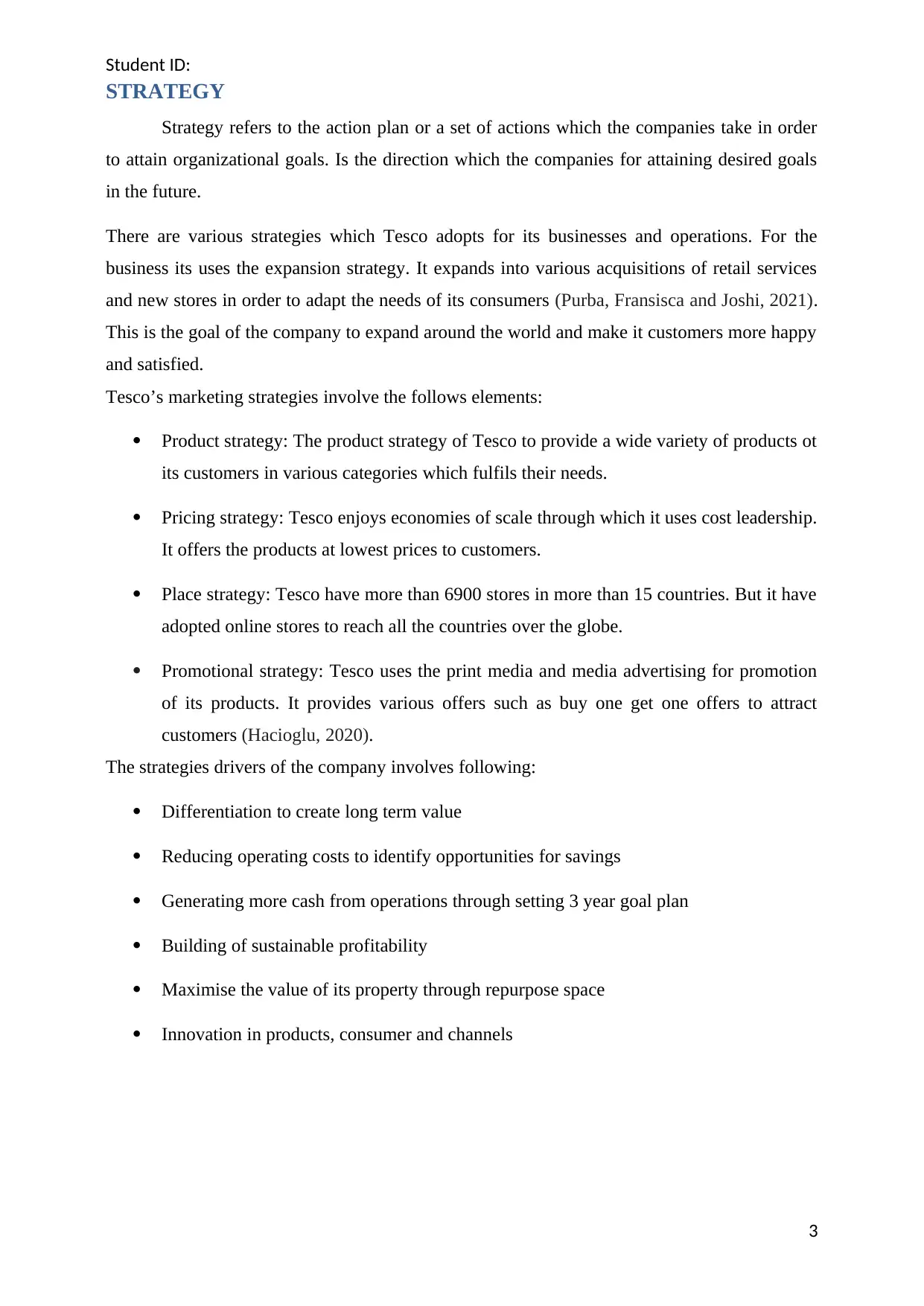
Student ID:
STRATEGY
Strategy refers to the action plan or a set of actions which the companies take in order
to attain organizational goals. Is the direction which the companies for attaining desired goals
in the future.
There are various strategies which Tesco adopts for its businesses and operations. For the
business its uses the expansion strategy. It expands into various acquisitions of retail services
and new stores in order to adapt the needs of its consumers (Purba, Fransisca and Joshi, 2021).
This is the goal of the company to expand around the world and make it customers more happy
and satisfied.
Tesco’s marketing strategies involve the follows elements:
Product strategy: The product strategy of Tesco to provide a wide variety of products ot
its customers in various categories which fulfils their needs.
Pricing strategy: Tesco enjoys economies of scale through which it uses cost leadership.
It offers the products at lowest prices to customers.
Place strategy: Tesco have more than 6900 stores in more than 15 countries. But it have
adopted online stores to reach all the countries over the globe.
Promotional strategy: Tesco uses the print media and media advertising for promotion
of its products. It provides various offers such as buy one get one offers to attract
customers (Hacioglu, 2020).
The strategies drivers of the company involves following:
Differentiation to create long term value
Reducing operating costs to identify opportunities for savings
Generating more cash from operations through setting 3 year goal plan
Building of sustainable profitability
Maximise the value of its property through repurpose space
Innovation in products, consumer and channels
3
STRATEGY
Strategy refers to the action plan or a set of actions which the companies take in order
to attain organizational goals. Is the direction which the companies for attaining desired goals
in the future.
There are various strategies which Tesco adopts for its businesses and operations. For the
business its uses the expansion strategy. It expands into various acquisitions of retail services
and new stores in order to adapt the needs of its consumers (Purba, Fransisca and Joshi, 2021).
This is the goal of the company to expand around the world and make it customers more happy
and satisfied.
Tesco’s marketing strategies involve the follows elements:
Product strategy: The product strategy of Tesco to provide a wide variety of products ot
its customers in various categories which fulfils their needs.
Pricing strategy: Tesco enjoys economies of scale through which it uses cost leadership.
It offers the products at lowest prices to customers.
Place strategy: Tesco have more than 6900 stores in more than 15 countries. But it have
adopted online stores to reach all the countries over the globe.
Promotional strategy: Tesco uses the print media and media advertising for promotion
of its products. It provides various offers such as buy one get one offers to attract
customers (Hacioglu, 2020).
The strategies drivers of the company involves following:
Differentiation to create long term value
Reducing operating costs to identify opportunities for savings
Generating more cash from operations through setting 3 year goal plan
Building of sustainable profitability
Maximise the value of its property through repurpose space
Innovation in products, consumer and channels
3
⊘ This is a preview!⊘
Do you want full access?
Subscribe today to unlock all pages.

Trusted by 1+ million students worldwide
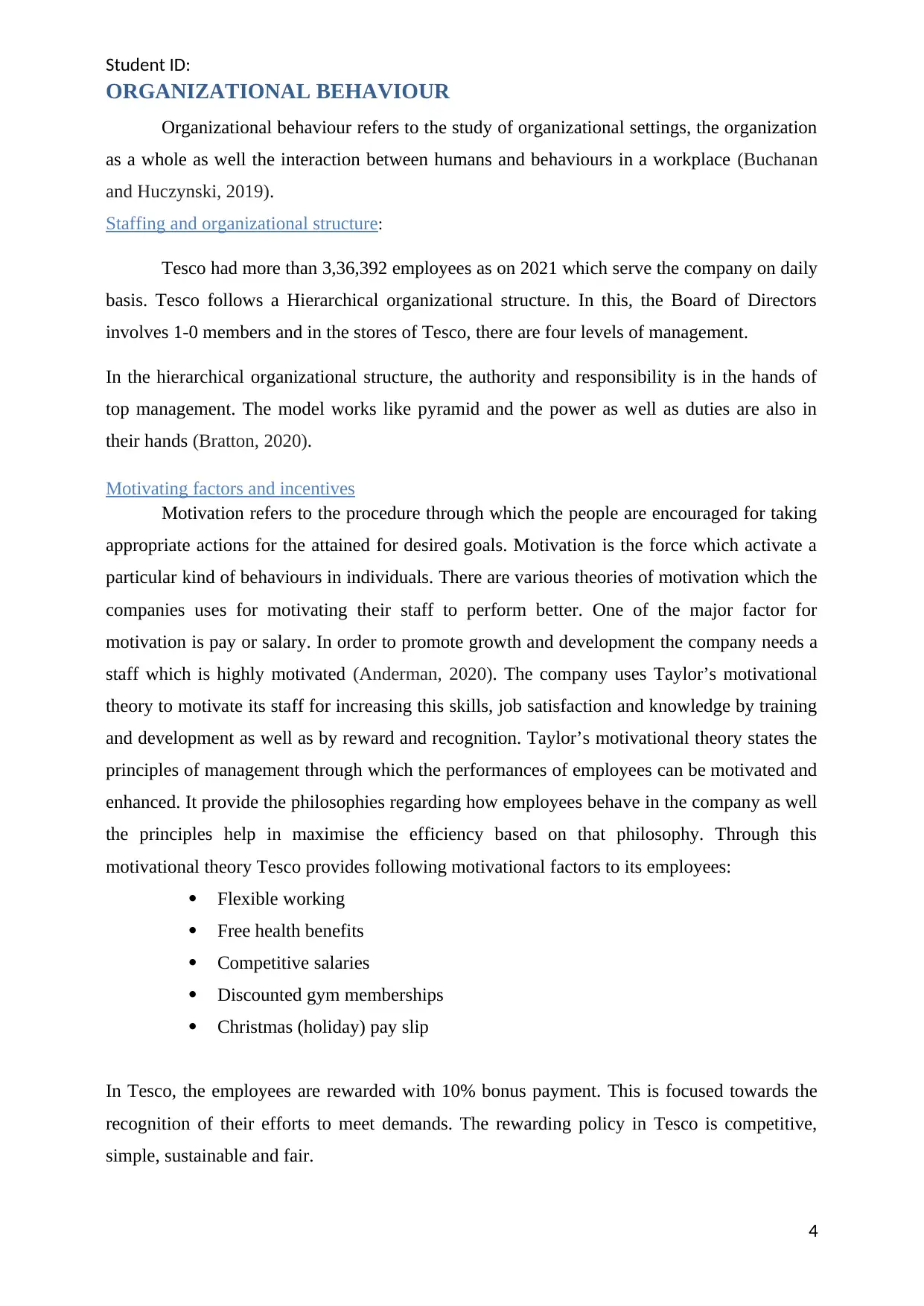
Student ID:
ORGANIZATIONAL BEHAVIOUR
Organizational behaviour refers to the study of organizational settings, the organization
as a whole as well the interaction between humans and behaviours in a workplace (Buchanan
and Huczynski, 2019).
Staffing and organizational structure:
Tesco had more than 3,36,392 employees as on 2021 which serve the company on daily
basis. Tesco follows a Hierarchical organizational structure. In this, the Board of Directors
involves 1-0 members and in the stores of Tesco, there are four levels of management.
In the hierarchical organizational structure, the authority and responsibility is in the hands of
top management. The model works like pyramid and the power as well as duties are also in
their hands (Bratton, 2020).
Motivating factors and incentives
Motivation refers to the procedure through which the people are encouraged for taking
appropriate actions for the attained for desired goals. Motivation is the force which activate a
particular kind of behaviours in individuals. There are various theories of motivation which the
companies uses for motivating their staff to perform better. One of the major factor for
motivation is pay or salary. In order to promote growth and development the company needs a
staff which is highly motivated (Anderman, 2020). The company uses Taylor’s motivational
theory to motivate its staff for increasing this skills, job satisfaction and knowledge by training
and development as well as by reward and recognition. Taylor’s motivational theory states the
principles of management through which the performances of employees can be motivated and
enhanced. It provide the philosophies regarding how employees behave in the company as well
the principles help in maximise the efficiency based on that philosophy. Through this
motivational theory Tesco provides following motivational factors to its employees:
Flexible working
Free health benefits
Competitive salaries
Discounted gym memberships
Christmas (holiday) pay slip
In Tesco, the employees are rewarded with 10% bonus payment. This is focused towards the
recognition of their efforts to meet demands. The rewarding policy in Tesco is competitive,
simple, sustainable and fair.
4
ORGANIZATIONAL BEHAVIOUR
Organizational behaviour refers to the study of organizational settings, the organization
as a whole as well the interaction between humans and behaviours in a workplace (Buchanan
and Huczynski, 2019).
Staffing and organizational structure:
Tesco had more than 3,36,392 employees as on 2021 which serve the company on daily
basis. Tesco follows a Hierarchical organizational structure. In this, the Board of Directors
involves 1-0 members and in the stores of Tesco, there are four levels of management.
In the hierarchical organizational structure, the authority and responsibility is in the hands of
top management. The model works like pyramid and the power as well as duties are also in
their hands (Bratton, 2020).
Motivating factors and incentives
Motivation refers to the procedure through which the people are encouraged for taking
appropriate actions for the attained for desired goals. Motivation is the force which activate a
particular kind of behaviours in individuals. There are various theories of motivation which the
companies uses for motivating their staff to perform better. One of the major factor for
motivation is pay or salary. In order to promote growth and development the company needs a
staff which is highly motivated (Anderman, 2020). The company uses Taylor’s motivational
theory to motivate its staff for increasing this skills, job satisfaction and knowledge by training
and development as well as by reward and recognition. Taylor’s motivational theory states the
principles of management through which the performances of employees can be motivated and
enhanced. It provide the philosophies regarding how employees behave in the company as well
the principles help in maximise the efficiency based on that philosophy. Through this
motivational theory Tesco provides following motivational factors to its employees:
Flexible working
Free health benefits
Competitive salaries
Discounted gym memberships
Christmas (holiday) pay slip
In Tesco, the employees are rewarded with 10% bonus payment. This is focused towards the
recognition of their efforts to meet demands. The rewarding policy in Tesco is competitive,
simple, sustainable and fair.
4
Paraphrase This Document
Need a fresh take? Get an instant paraphrase of this document with our AI Paraphraser
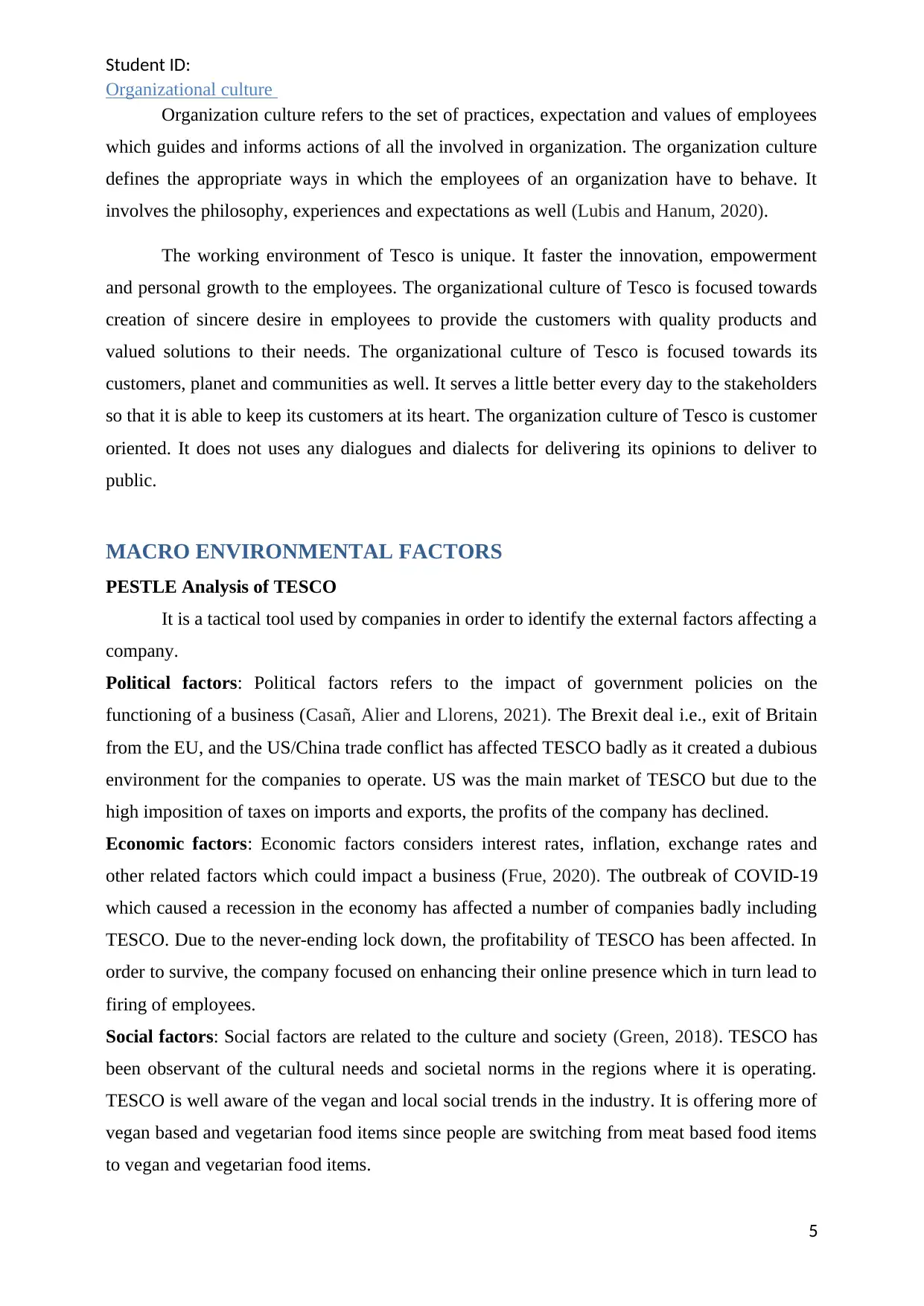
Student ID:
Organizational culture
Organization culture refers to the set of practices, expectation and values of employees
which guides and informs actions of all the involved in organization. The organization culture
defines the appropriate ways in which the employees of an organization have to behave. It
involves the philosophy, experiences and expectations as well (Lubis and Hanum, 2020).
The working environment of Tesco is unique. It faster the innovation, empowerment
and personal growth to the employees. The organizational culture of Tesco is focused towards
creation of sincere desire in employees to provide the customers with quality products and
valued solutions to their needs. The organizational culture of Tesco is focused towards its
customers, planet and communities as well. It serves a little better every day to the stakeholders
so that it is able to keep its customers at its heart. The organization culture of Tesco is customer
oriented. It does not uses any dialogues and dialects for delivering its opinions to deliver to
public.
MACRO ENVIRONMENTAL FACTORS
PESTLE Analysis of TESCO
It is a tactical tool used by companies in order to identify the external factors affecting a
company.
Political factors: Political factors refers to the impact of government policies on the
functioning of a business (Casañ, Alier and Llorens, 2021). The Brexit deal i.e., exit of Britain
from the EU, and the US/China trade conflict has affected TESCO badly as it created a dubious
environment for the companies to operate. US was the main market of TESCO but due to the
high imposition of taxes on imports and exports, the profits of the company has declined.
Economic factors: Economic factors considers interest rates, inflation, exchange rates and
other related factors which could impact a business (Frue, 2020). The outbreak of COVID-19
which caused a recession in the economy has affected a number of companies badly including
TESCO. Due to the never-ending lock down, the profitability of TESCO has been affected. In
order to survive, the company focused on enhancing their online presence which in turn lead to
firing of employees.
Social factors: Social factors are related to the culture and society (Green, 2018). TESCO has
been observant of the cultural needs and societal norms in the regions where it is operating.
TESCO is well aware of the vegan and local social trends in the industry. It is offering more of
vegan based and vegetarian food items since people are switching from meat based food items
to vegan and vegetarian food items.
5
Organizational culture
Organization culture refers to the set of practices, expectation and values of employees
which guides and informs actions of all the involved in organization. The organization culture
defines the appropriate ways in which the employees of an organization have to behave. It
involves the philosophy, experiences and expectations as well (Lubis and Hanum, 2020).
The working environment of Tesco is unique. It faster the innovation, empowerment
and personal growth to the employees. The organizational culture of Tesco is focused towards
creation of sincere desire in employees to provide the customers with quality products and
valued solutions to their needs. The organizational culture of Tesco is focused towards its
customers, planet and communities as well. It serves a little better every day to the stakeholders
so that it is able to keep its customers at its heart. The organization culture of Tesco is customer
oriented. It does not uses any dialogues and dialects for delivering its opinions to deliver to
public.
MACRO ENVIRONMENTAL FACTORS
PESTLE Analysis of TESCO
It is a tactical tool used by companies in order to identify the external factors affecting a
company.
Political factors: Political factors refers to the impact of government policies on the
functioning of a business (Casañ, Alier and Llorens, 2021). The Brexit deal i.e., exit of Britain
from the EU, and the US/China trade conflict has affected TESCO badly as it created a dubious
environment for the companies to operate. US was the main market of TESCO but due to the
high imposition of taxes on imports and exports, the profits of the company has declined.
Economic factors: Economic factors considers interest rates, inflation, exchange rates and
other related factors which could impact a business (Frue, 2020). The outbreak of COVID-19
which caused a recession in the economy has affected a number of companies badly including
TESCO. Due to the never-ending lock down, the profitability of TESCO has been affected. In
order to survive, the company focused on enhancing their online presence which in turn lead to
firing of employees.
Social factors: Social factors are related to the culture and society (Green, 2018). TESCO has
been observant of the cultural needs and societal norms in the regions where it is operating.
TESCO is well aware of the vegan and local social trends in the industry. It is offering more of
vegan based and vegetarian food items since people are switching from meat based food items
to vegan and vegetarian food items.
5
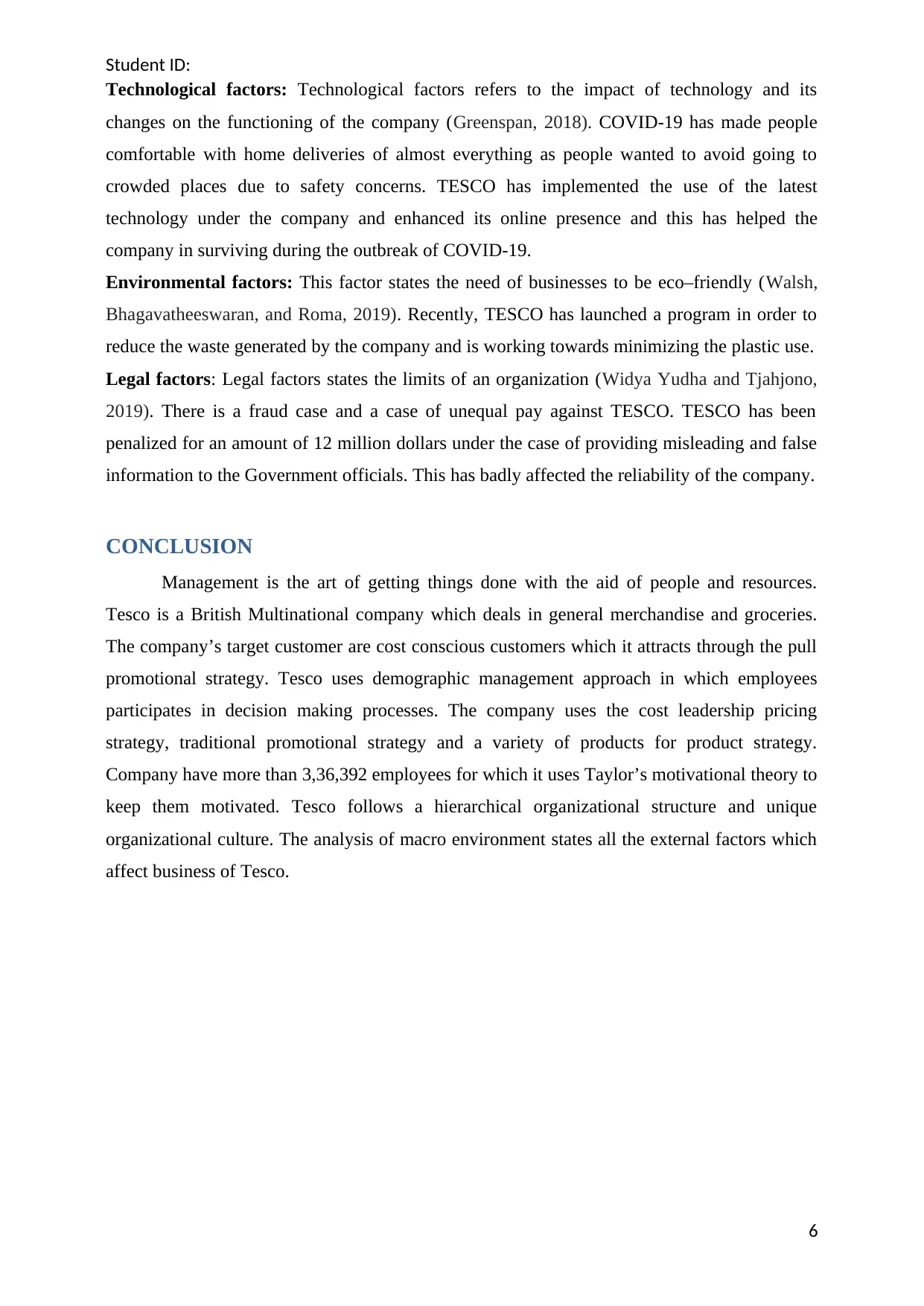
Student ID:
Technological factors: Technological factors refers to the impact of technology and its
changes on the functioning of the company (Greenspan, 2018). COVID-19 has made people
comfortable with home deliveries of almost everything as people wanted to avoid going to
crowded places due to safety concerns. TESCO has implemented the use of the latest
technology under the company and enhanced its online presence and this has helped the
company in surviving during the outbreak of COVID-19.
Environmental factors: This factor states the need of businesses to be eco–friendly (Walsh,
Bhagavatheeswaran, and Roma, 2019). Recently, TESCO has launched a program in order to
reduce the waste generated by the company and is working towards minimizing the plastic use.
Legal factors: Legal factors states the limits of an organization (Widya Yudha and Tjahjono,
2019). There is a fraud case and a case of unequal pay against TESCO. TESCO has been
penalized for an amount of 12 million dollars under the case of providing misleading and false
information to the Government officials. This has badly affected the reliability of the company.
CONCLUSION
Management is the art of getting things done with the aid of people and resources.
Tesco is a British Multinational company which deals in general merchandise and groceries.
The company’s target customer are cost conscious customers which it attracts through the pull
promotional strategy. Tesco uses demographic management approach in which employees
participates in decision making processes. The company uses the cost leadership pricing
strategy, traditional promotional strategy and a variety of products for product strategy.
Company have more than 3,36,392 employees for which it uses Taylor’s motivational theory to
keep them motivated. Tesco follows a hierarchical organizational structure and unique
organizational culture. The analysis of macro environment states all the external factors which
affect business of Tesco.
6
Technological factors: Technological factors refers to the impact of technology and its
changes on the functioning of the company (Greenspan, 2018). COVID-19 has made people
comfortable with home deliveries of almost everything as people wanted to avoid going to
crowded places due to safety concerns. TESCO has implemented the use of the latest
technology under the company and enhanced its online presence and this has helped the
company in surviving during the outbreak of COVID-19.
Environmental factors: This factor states the need of businesses to be eco–friendly (Walsh,
Bhagavatheeswaran, and Roma, 2019). Recently, TESCO has launched a program in order to
reduce the waste generated by the company and is working towards minimizing the plastic use.
Legal factors: Legal factors states the limits of an organization (Widya Yudha and Tjahjono,
2019). There is a fraud case and a case of unequal pay against TESCO. TESCO has been
penalized for an amount of 12 million dollars under the case of providing misleading and false
information to the Government officials. This has badly affected the reliability of the company.
CONCLUSION
Management is the art of getting things done with the aid of people and resources.
Tesco is a British Multinational company which deals in general merchandise and groceries.
The company’s target customer are cost conscious customers which it attracts through the pull
promotional strategy. Tesco uses demographic management approach in which employees
participates in decision making processes. The company uses the cost leadership pricing
strategy, traditional promotional strategy and a variety of products for product strategy.
Company have more than 3,36,392 employees for which it uses Taylor’s motivational theory to
keep them motivated. Tesco follows a hierarchical organizational structure and unique
organizational culture. The analysis of macro environment states all the external factors which
affect business of Tesco.
6
⊘ This is a preview!⊘
Do you want full access?
Subscribe today to unlock all pages.

Trusted by 1+ million students worldwide
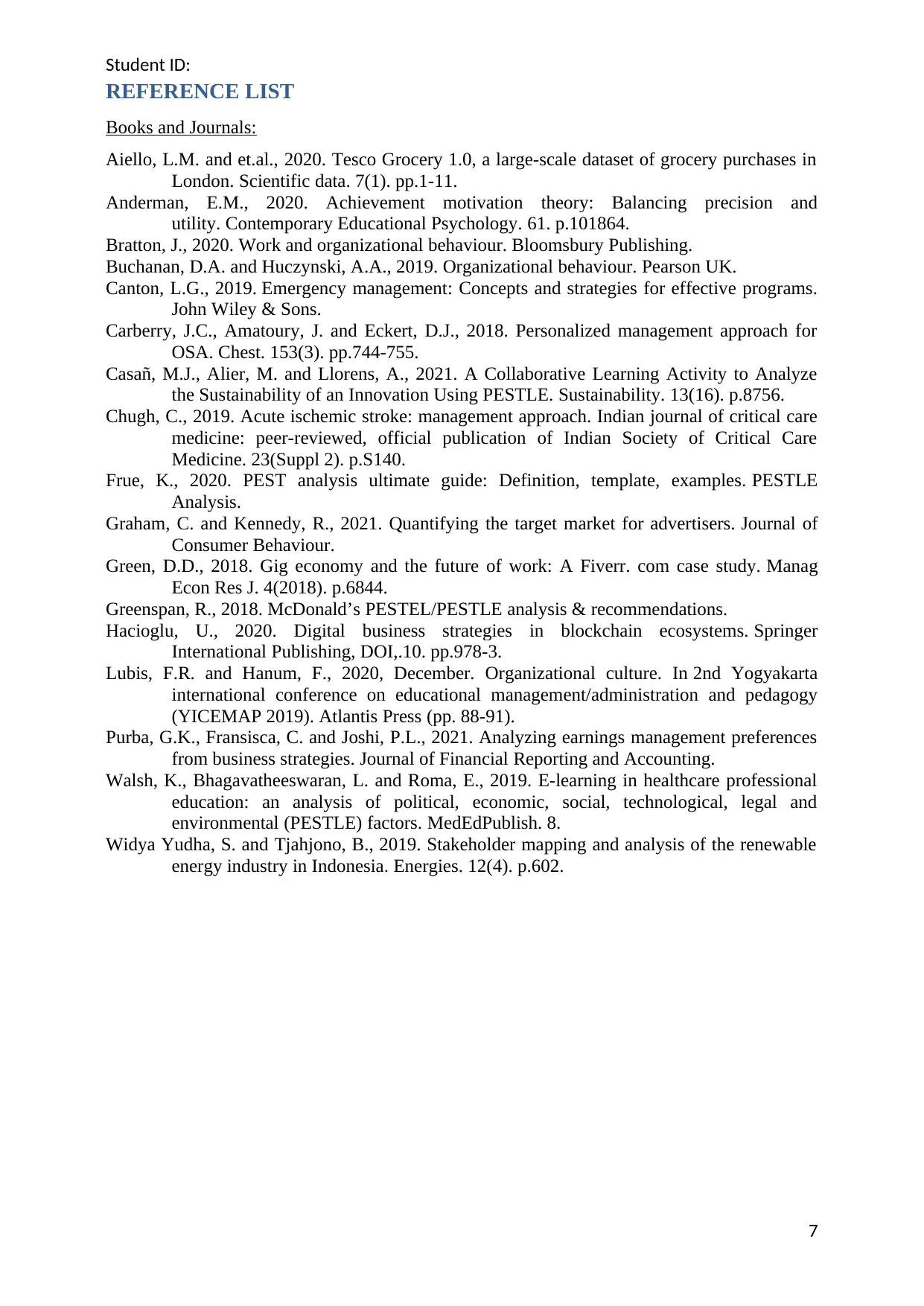
Student ID:
REFERENCE LIST
Books and Journals:
Aiello, L.M. and et.al., 2020. Tesco Grocery 1.0, a large-scale dataset of grocery purchases in
London. Scientific data. 7(1). pp.1-11.
Anderman, E.M., 2020. Achievement motivation theory: Balancing precision and
utility. Contemporary Educational Psychology. 61. p.101864.
Bratton, J., 2020. Work and organizational behaviour. Bloomsbury Publishing.
Buchanan, D.A. and Huczynski, A.A., 2019. Organizational behaviour. Pearson UK.
Canton, L.G., 2019. Emergency management: Concepts and strategies for effective programs.
John Wiley & Sons.
Carberry, J.C., Amatoury, J. and Eckert, D.J., 2018. Personalized management approach for
OSA. Chest. 153(3). pp.744-755.
Casañ, M.J., Alier, M. and Llorens, A., 2021. A Collaborative Learning Activity to Analyze
the Sustainability of an Innovation Using PESTLE. Sustainability. 13(16). p.8756.
Chugh, C., 2019. Acute ischemic stroke: management approach. Indian journal of critical care
medicine: peer-reviewed, official publication of Indian Society of Critical Care
Medicine. 23(Suppl 2). p.S140.
Frue, K., 2020. PEST analysis ultimate guide: Definition, template, examples. PESTLE
Analysis.
Graham, C. and Kennedy, R., 2021. Quantifying the target market for advertisers. Journal of
Consumer Behaviour.
Green, D.D., 2018. Gig economy and the future of work: A Fiverr. com case study. Manag
Econ Res J. 4(2018). p.6844.
Greenspan, R., 2018. McDonald’s PESTEL/PESTLE analysis & recommendations.
Hacioglu, U., 2020. Digital business strategies in blockchain ecosystems. Springer
International Publishing, DOI,.10. pp.978-3.
Lubis, F.R. and Hanum, F., 2020, December. Organizational culture. In 2nd Yogyakarta
international conference on educational management/administration and pedagogy
(YICEMAP 2019). Atlantis Press (pp. 88-91).
Purba, G.K., Fransisca, C. and Joshi, P.L., 2021. Analyzing earnings management preferences
from business strategies. Journal of Financial Reporting and Accounting.
Walsh, K., Bhagavatheeswaran, L. and Roma, E., 2019. E-learning in healthcare professional
education: an analysis of political, economic, social, technological, legal and
environmental (PESTLE) factors. MedEdPublish. 8.
Widya Yudha, S. and Tjahjono, B., 2019. Stakeholder mapping and analysis of the renewable
energy industry in Indonesia. Energies. 12(4). p.602.
7
REFERENCE LIST
Books and Journals:
Aiello, L.M. and et.al., 2020. Tesco Grocery 1.0, a large-scale dataset of grocery purchases in
London. Scientific data. 7(1). pp.1-11.
Anderman, E.M., 2020. Achievement motivation theory: Balancing precision and
utility. Contemporary Educational Psychology. 61. p.101864.
Bratton, J., 2020. Work and organizational behaviour. Bloomsbury Publishing.
Buchanan, D.A. and Huczynski, A.A., 2019. Organizational behaviour. Pearson UK.
Canton, L.G., 2019. Emergency management: Concepts and strategies for effective programs.
John Wiley & Sons.
Carberry, J.C., Amatoury, J. and Eckert, D.J., 2018. Personalized management approach for
OSA. Chest. 153(3). pp.744-755.
Casañ, M.J., Alier, M. and Llorens, A., 2021. A Collaborative Learning Activity to Analyze
the Sustainability of an Innovation Using PESTLE. Sustainability. 13(16). p.8756.
Chugh, C., 2019. Acute ischemic stroke: management approach. Indian journal of critical care
medicine: peer-reviewed, official publication of Indian Society of Critical Care
Medicine. 23(Suppl 2). p.S140.
Frue, K., 2020. PEST analysis ultimate guide: Definition, template, examples. PESTLE
Analysis.
Graham, C. and Kennedy, R., 2021. Quantifying the target market for advertisers. Journal of
Consumer Behaviour.
Green, D.D., 2018. Gig economy and the future of work: A Fiverr. com case study. Manag
Econ Res J. 4(2018). p.6844.
Greenspan, R., 2018. McDonald’s PESTEL/PESTLE analysis & recommendations.
Hacioglu, U., 2020. Digital business strategies in blockchain ecosystems. Springer
International Publishing, DOI,.10. pp.978-3.
Lubis, F.R. and Hanum, F., 2020, December. Organizational culture. In 2nd Yogyakarta
international conference on educational management/administration and pedagogy
(YICEMAP 2019). Atlantis Press (pp. 88-91).
Purba, G.K., Fransisca, C. and Joshi, P.L., 2021. Analyzing earnings management preferences
from business strategies. Journal of Financial Reporting and Accounting.
Walsh, K., Bhagavatheeswaran, L. and Roma, E., 2019. E-learning in healthcare professional
education: an analysis of political, economic, social, technological, legal and
environmental (PESTLE) factors. MedEdPublish. 8.
Widya Yudha, S. and Tjahjono, B., 2019. Stakeholder mapping and analysis of the renewable
energy industry in Indonesia. Energies. 12(4). p.602.
7
Paraphrase This Document
Need a fresh take? Get an instant paraphrase of this document with our AI Paraphraser
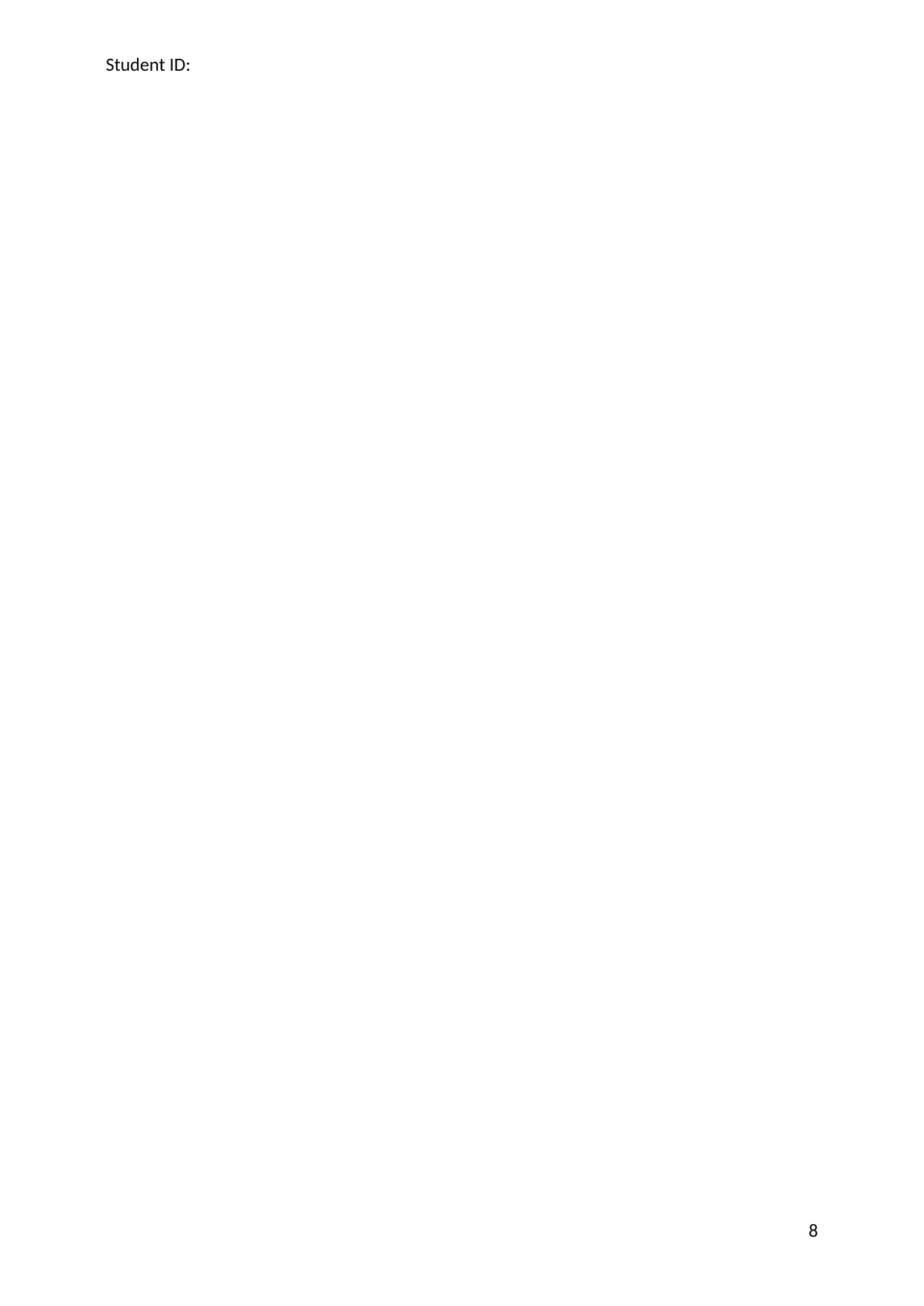
Student ID:
8
8
1 out of 11
Related Documents
Your All-in-One AI-Powered Toolkit for Academic Success.
+13062052269
info@desklib.com
Available 24*7 on WhatsApp / Email
![[object Object]](/_next/static/media/star-bottom.7253800d.svg)
Unlock your academic potential
Copyright © 2020–2025 A2Z Services. All Rights Reserved. Developed and managed by ZUCOL.





